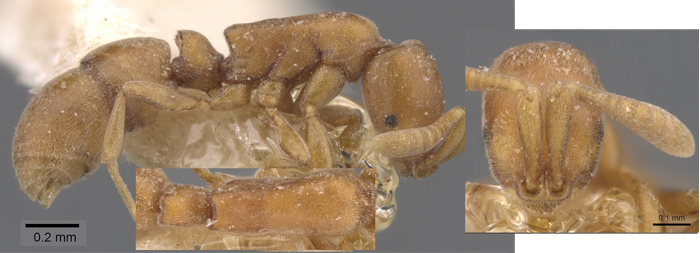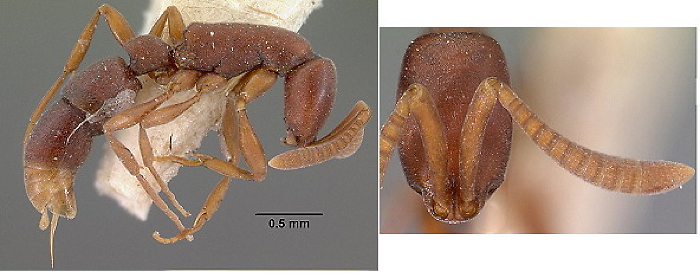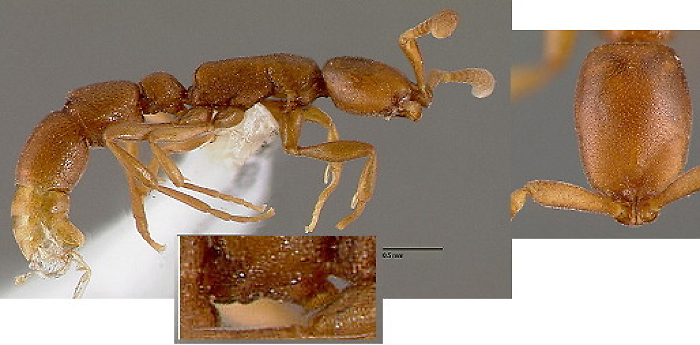SUBFAMILY PROCERATIINAE
Genus Probolomyrmex
| The Ants of
Africa SUBFAMILY PROCERATIINAE Genus Probolomyrmex |
|
| Contents - Proceratiinae - PROCERATIINAE Introduction |
In Tribe PROBOLOMYRMECINI
Diagnostic Features - No frontal lobes, these are represented by a thin rounded vertical plate separating the antennal insertions, in full face view, the antennal sockets entirely visible. Clypeus fused to frontal carinae and forming a plate which projects forward above the small curved mandibles, which are modified-triangular. Compound eyes usually absent. Antennal scapes fail to reach posterior border of head by a considerable distance. Alitrunk completely fused into a single structure without dorsal sutures. Middle and hind tibiae each with a single pectinate spur. Full adult colour yellowish-brown to red-brown. Small TL 2.4-4.2 mm.
Mayr's (1901b) genus definition is at ![]() . Arnold (1915) gave a translation; this is
at
. Arnold (1915) gave a translation; this is
at ![]() . Junior synonym Escherichia
(Forel, 1910c: 245), type species Escherichia brevirostris -
see
. Junior synonym Escherichia
(Forel, 1910c: 245), type species Escherichia brevirostris -
see ![]() .
.
Genus revised by Taylor (1965d) and were considered also by Brown (1975). Most members of the genus are from savannah areas and Brown noted all appear to be rare and relatively cryptic (or nocturnal). Mainly collected in forest litter or soil, nest in hollow twigs, burrows or small pieces of rotten wood in or on the soil. Food unknown.
The three species known from Africa can be separated as follows (after Taylor, 1965d: 352) -
| 1 |  Only known specimen
with compound eyes; also small with a much shorter petiolar node Only known specimen
with compound eyes; also small with a much shorter petiolar node |
. |
| . |  |
N.E. Africa (Eritrea, Uganda) - brevirostris |
| 2 |  Larger species, HL
> 0.76 mm, WL > 1 mm (WL = Weber's length of mesosoma, actually
alitrunk diagonal length) - unique holotype with petiole node slightly
higher than long, face moderately shining, very finely shagreened and
near smooth Larger species, HL
> 0.76 mm, WL > 1 mm (WL = Weber's length of mesosoma, actually
alitrunk diagonal length) - unique holotype with petiole node slightly
higher than long, face moderately shining, very finely shagreened and
near smooth |
South Africa - filiformis |
| 3 |  Smaller species, HL
< 0.61 mm, WL < 0.88 mm Smaller species, HL
< 0.61 mm, WL < 0.88 mm |
Guinea, West Africa - guineensis |
| 4 |  Similar in overall
size to guineensis but approximate dimensions HW 0.37 mm, HL
0.57, SL 0.32, SI 86; petiole relatively short and domed with deeply
convex posterior face; petiole with sharp end to ventral process Similar in overall
size to guineensis but approximate dimensions HW 0.37 mm, HL
0.57, SL 0.32, SI 86; petiole relatively short and domed with deeply
convex posterior face; petiole with sharp end to ventral process |
South Africa - Probolomyrmex new species C7939 |
| PONERINAE Introduction |
© 2007, 2008, 2012, 2014 - Brian Taylor CBiol FSB FRES 11, Grazingfield, Wilford, Nottingham, NG11 7FN, U.K. |
href="probolomyrmex.htm"